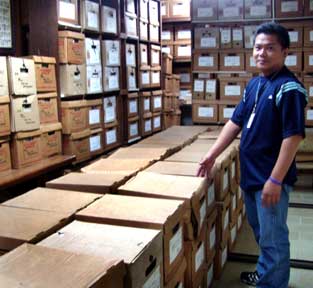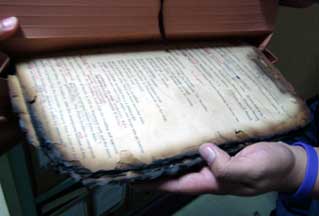The ‘Cemetery’ Inside
the House
Down the basement of
the House of Representatives is the legislative archives that only
academic researchers and enterprising reporters probably visit. Although
the archive’s tens of thousands of old and crumpled documents are
historical, they also attest to Congress’ record of performance – or
non-performance.
BY AUBREY SC MAKILAN
Bulatlat
|
Albert Relosa, 33,
has been working in the Legislative Archives Service of the House of
Representatives in Quezon City for about five years now. When a
congressional term ends, he receives all the documents, including those
related with bills that the House did not pass. Thus, congressmen and
House employees call Relosa’s office “the cemetery” since most of the
documents it stores were “killed” bills.
Relosa however says
he feels saddened whenever he sees a “killed” bill, particularly ones that
he thinks would have benefited many people, such as the bills on the P125
across-the-board wage increase for workers – which has been refiled four
times now and is currently on the second reading – and on the P3,000 wage
hike for government employees.
|

Boxes of
documents can be seen all over the Legislative Archives Service office |
“My wife is a teacher
and the P3,000 wage increase would have been of great help to us,” he
said. “I’m still hopeful it would be passed.”
Relosa said that
about 75 percent of the bills from one Congress term are “killed” or do
not become “republic acts.”
In the 12th
Congress, the House filed 6,697 bills while the Senate had 2,749 or a
total of 9,446 bills. Out of the total only 76 bills (or just 1 percent)
were enacted into law. Before that, the 11th Congress (both
House and the Senate) had 15,244 bills. Of these, only 415 or 3 percent
became law.
Limitations
The Archives Service
is home to Congressional documents dating as far back as 1946. Earlier
documents which had only one copy, such as the 1899 Malolos Constitution,
have been placed in a gallery inside the House. Likewise, files before the
1970s are no longer allowed to be photocopied since light and moist
contribute to the deterioration of the paper.
A staff who refused
to be identified told Bulatlat that it is the prerogative of the
conservation section head whether to allow or prohibit the use of these
materials. But in requests involving a political dynasty, the staff said,
their section head could not say no. Once, he said, a younger politician
requested for photocopies because he wanted to re-file his father’s bill.
“The section head has the last say. How can he say no to a congressman?”
he said.
Since the documents
are accumulating after every Congressional term, the Archives Service has
been lacking in space for storage. Most of the shelves were only
improvised cabinets made by men from the Engineering Department. And since
the office does not have enough space to accommodate as many cabinets as
possible, they resort to piling the carton boxes containing committee
papers.
But Alvin Manuel, 33,
who has been with the conservation section of the Archives Service for
seven years, said that even these cartons were not as durable as the ones
they were issued three years ago. The ones they are using now crumple
easily. He also told Bulatlat that the pile of boxes should be up
to two levels only but because of space limitations, they themselves do
not have a choice but to violate their own rule.
The boxes could be
seen in all corners of the rooms. At the backmost part of the conservation
room can be seen a pile of boxes and other “trash.” Manuel calls this
their bodega (storage room) but he admitted that this is also where
they place documents that are rarely used and looked for.
Carton boxes can even
be found in the readers’ area, where the air conditioner can not support
the needed temperature for preservation. But even inside the conservation
room, only one air conditioner is functional.
With the government’s
cost-cutting measures, the air conditioning units are turned off after
office hours and opened at 8 a.m. the following day, unlike in the past
when they were opened the whole day.
Digitization
With the advances in
technology, the Archives Service’s members want to catch up by pushing the
digitization of their system.
The normal practice
of preserving a document is by putting each paper in a mylar film, a
non-acidic polyester transparent film. But budget constraints would not
allow them to do these for all the documents.

Untreated document due
to lack of budget |
In fact, there are
still so many papers left untreated. This includes documents rescued from
a fire that struck the old Batasang Pambansa complex. Manuel was very
careful in bringing out a half burnt copy of committee documents to show
to Bulatlat.
Papers like these
should have been converted to a microfilm but then, their microfilm
machines have been inoperative for three years now. Because of this, they
could not do the reel-to-reel tape transferring which is another
preservation method for documents.
|
The only thing left
that they can do is to put silica gels in the reel case to prevent molds
from forming. But again, their budget could not provide enough silica gels
for all the reel tapes.
Aside from the
microfilm machine, Manuel also said that of the three reel tape players,
only one is functional. Worse, they have no player for umatic tapes, which
contain Congressional activities. Viewers would still need to go to the
Media Office to see them.
“In the digitization
process, these tapes would be converted into compact discs,” Manuel said,
“but this may take long to be completed considering our insufficient
budget.” Bulatlat
All
photos by Aubrey Makilan
BACK TO
TOP ■
PRINTER-FRIENDLY VERSION ■
COMMENT
© 2004 Bulatlat
■
Alipato Publications
Permission is granted to reprint or redistribute this article, provided
its author/s and Bulatlat are properly credited and notified.